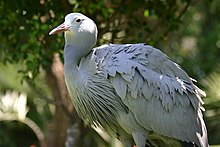Anthropoides paradiseus
| Blue crane | |
|---|---|
 |
|
| Scientific classification | |
| Kingdom: | Animalia |
| Phylum: | Chordata |
| Class: | Aves |
| Order: | Gruiformes |
| Family: | Gruidae |
| Genus: | Grus |
| Species: | G. paradisea |
| Binomial name | |
|
Grus paradisea (Lichtenstein, AAH, 1793) [originally Ardea] |
|
| Synonyms | |
|
|
The blue crane (Grus paradisea), also known as the Stanley crane and the paradise crane, is the national bird of South Africa. The species is listed as Vulnerable by the IUCN.
The blue crane is a tall, ground-dwelling bird, but is fairly small by the standards of the crane family. It is 100–120 cm (3 ft 3 in–3 ft 11 in) tall, with a wingspan of 180–200 cm (5 ft 11 in–6 ft 7 in) and weighs 3.6–6.2 kg (7.9–13.7 lb). Among standard measurements, the wing chord measures 51.4–59 cm (20.2–23.2 in), the exposed culmen measures 8–10 cm (3.1–3.9 in) and the tarsus measures 20.5–25.2 cm (8.1–9.9 in). This crane is pale blue-gray in colour becoming darker on the upper head, neck and nape. From the crown to the lores, the plumage is distinctly lighter, sometimes whitish. The bill is ochre to greyish, with a pink tinge. The long wingtip feathers which trail to the ground. The primaries are black to slate grey, with dark coverts and blackish on the secondaries. Unlike most cranes, it has a relatively large head and a proportionately thin neck. Juveniles are similar but slightly lighter, with tawny coloration on the head, and no long wing plumes.
Blue cranes are birds of the dry grassy uplands, usually the pastured grasses of hills, valleys, and plains with a few scattered trees. They prefer areas in the nesting season that have access to both upland and wetland areas, though they feed almost entirely in dry areas. They are altitudinal migrants, generally nesting in the lower grasslands of an elevation of around 1,300 to 2,000 m and moving down to lower altitudes for winter. Though historically found in areas of low human disturbance, the blue crane is currently thriving in the highly transformed agricultural areas of the Western Cape. This is the only portion of its range where the population is increasing, though they still face threats such as poisoning in the region.bio0
Of the 15 species of crane, the blue crane has the most restricted distribution of all. Even species with lower population numbers now (such as Siberian or whooping cranes) are found over a considerable range in their migratory movements. The blue crane is migratory, primarily altitudinal, but details are little known.
The blue crane is partially social, less so during the breeding season. There is a strict hierarchy in groups, with the larger adult males being dominant. They overlap in range with 3 other crane species but interactions with these species and other "large wader" type birds are not known. They are relentlessly aggressive to various other animals during the nesting season, attacking non-predatory species such as cattle, tortoises, plovers and even sparrows. Humans are also attacked if they approach a nest too closely, with the aggressive male having torn clothes and drawn blood in such cases.
...
Wikipedia

